Structural Monitoring of a Large Archaeological Wooden Structure in Real Time, Post PEG Treatment
Abstract
:1. Introduction
2. Methods and Measuring Systems
- Errors in the total station data, such as a sudden and constant shift in the Z direction data of more than 10 mm that was stable over a long period of time, were removed. The source of this shift has not been conclusively proven, but is likely to be a hardware error since the recording returned to normal after some time and the oscillation desisted of its own accord.
- For the total displacement plots, a scatter graph was plotted showing the total displacement against time for each target in each direction.
- For the displacement rate plots, a curve of best fit was plotted on each target’s dataset. The fitted curve was then differentiated to find the rate of change.
3. Results and Discussion
3.1. Total Displacement of the TS Targets in the X, Y and Z Directions Respresented on the Ship
3.2. Cumulative Displacement of the TS Targets in the X, Y and Z Directions over the Time Period (2013–2020)
3.3. Displacement Rate of the TS Targets in the X, Y and Z Directions over the Time Period (2013–2020)
4. Conclusions
- In the first year of drying, in the X, Y and Z directions, the highest displacement rates were 70, 110 and 100 mm/year, respectively, whereas after 6.5 years the highest displacement rates are an order of magnitude slower, at 5, 7 and 12 mm/year respectively. Evidently, the displacement rates have reduced significantly, which is a positive finding, indicating the stabilisation of the hull.
- This slower rate of displacement corresponds to an average displacement of the targets in the X, Y and Z directions between the period of recording (2013–2020) of approximately 50, 60 and 110 mm, respectively.
- Average displacement rates as of 2020 across all targets in the X, Y and Z directions are approximately 1.6, 2.3 and 5 mm/year respectively. The displacement rates are now reasonably small when considered in context of the approximately 30 m long ship.
- Finally, as a first analysis of current displacement rates to identify critical sections in need of intervention, the work conducted here alleviates any fears of significant further displacement.
Author Contributions
Funding
Institutional Review Board Statement
Informed Consent Statement
Data Availability Statement
Conflicts of Interest
References
- Varga, T.; Pauliny, P. Timber-traditional material history or vision in architectural design? In Advanced Materials Research; Trans Tech Publications Ltd.: Freienbach, Switzerland, 2014; Volume 899, pp. 460–465. [Google Scholar]
- Namichev, P.; Petrovski, M. Wood as a primary selection of material for furniture production. J. Process. Manag. New Technol. 2019, 7, 6–12. [Google Scholar] [CrossRef]
- Laures, F.F. The evolution of antique ship construction in the Mediterranean: A hypothesis. Int. J. Naut. Archaeol. 1984, 13, 323–325. [Google Scholar] [CrossRef]
- Majka, J.; Zborowska, M.; Fejfer, M.; Waliszewska, B.; Olek, W. Dimensional stability and hygroscopic properties of PEG treated irregularly degraded waterlogged Scots pine wood. J. Cult. Herit. 2018, 31, 133–140. [Google Scholar] [CrossRef]
- Eriksen, A.M.; Gregory, D.J.; Villa, C.; Lynnerup, N.; Botfeldt, K.B.; Rasmussen, A.R. The effects of wood anisotropy on the mode of attack by the woodborer Teredo navalis and the implications for underwater cultural heritage. Int. Biodeterior. Biodegrad. 2016, 107, 117–122. [Google Scholar] [CrossRef]
- Nagao, K.; Fujii, S. Effect of Moisture Content and Temperature on the Mechanical Properties of Food Models for Examining Thermal Conduction. J. Home Econ. Jpn. 2004, 55, 573–580. [Google Scholar]
- Vorobyev, A.; van Dijk, N.P.; Gamstedt, E.K. Orthotropic creep in polyethylene glycol impregnated archaeological oak from the Vasa ship: Results of creep experiments in a museum-like climate. Mech. Time-Depend. Mater. 2019, 23, 35–52. [Google Scholar] [CrossRef] [Green Version]
- Dionisi-Vici, P.; Allegretti, O.; Braovac, S.; Hjulstad, G.; Jensen, M.; Storbekk, E. The Oseberg ship. Long-term physical-mechanical monitoring in an uncontrolled relative humidity exhibition environment. Analytical results and hygromechanical modelling. In Proceedings of the Climate for Collections Standards and Uncertainties, Munich, Germany, 7–9 November 2012. [Google Scholar]
- Broda, M.; Mazela, B.; Królikowska-Pataraja, K.; Hill, C.A.S. The use of FT-IR and computed tomography non-destructive technique for waterlogged wood characterisation. Wood Res. 2015, 60, 707–722. [Google Scholar]
- Thybring, E.E.; Glass, S.V.; Zelinka, S.L. Kinetics of water vapor sorption in wood cell walls: State of the art and research needs. Forests 2019, 10, 704. [Google Scholar] [CrossRef] [Green Version]
- Björdal, C.G.; Nilsson, T. Waterlogged archaeological wood—A substrate for white rot fungi during drainage of wetlands. Int. Biodeterior. Biodegrad. 2002, 50, 17–23. [Google Scholar] [CrossRef]
- Kowalczuk, J.; Rachocki, A.; Broda, M.; Mazela, B.; Ormondroyd, G.A.; Tritt-Goc, J. Conservation process of archaeological waterlogged wood studied by spectroscopy and gradient NMR methods. Wood Sci. Technol. 2019, 53, 1207–1222. [Google Scholar] [CrossRef] [Green Version]
- Broda, M.; Hill, C.A.S. Conservation of waterlogged wood—Past, present and future perspectives. Forests 2021, 12, 1193. [Google Scholar] [CrossRef]
- McQueen, C.M.A.; Steindal, C.C.; Narygina, O.; Braovac, S. Temperature- and humidity-induced changes in alum-treated wood: A qualitative X-ray diffraction study. Herit. Sci. 2018, 6, 1–11. [Google Scholar] [CrossRef]
- Wagner, L.; Almkvist, G.; Bader, T.K.; Bjurhager, I.; Rautkari, L.; Gamstedt, E.K. The influence of chemical degradation and polyethylene glycol on moisture-dependent cell wall properties of archeological wooden objects: A case study of the Vasa shipwreck. Wood Sci. Technol. 2016, 50, 1103–1123. [Google Scholar] [CrossRef]
- Preston, J.; Smith, A.D.; Schofield, E.J.; Chadwick, A.V.; Jones, M.A.; Watts, J.E.M. The effects of Mary Rose conservation treatment on iron oxidation processes and microbial communities contributing to acid production in marine archaeological timbers. PLoS ONE 2014, 9, e84169. [Google Scholar] [CrossRef] [PubMed] [Green Version]
- Jones, M.; Schofield, E.J.; McConnachie, G. Air drying of the Mary Rose hull’. In Proceedings of the 12th ICOM-CC Group on Wet Organic Archaeological Materials Conference, Istanbul, Turkey, 13–17 May 2013. [Google Scholar]
- Piva, E. Conservation of a Tudor Warship: Investigating the Timbers of the Mary Rose; Portsmouth University: Portsmouth, UK, 2017. [Google Scholar]
- Nguyen, T.D.; Sakakibara, K.; Imai, T.; Tsujii, Y.; Kohdzuma, Y.; Sugiyama, J. Shrinkage and swelling behavior of archaeological waterlogged wood preserved with slightly crosslinked sodium polyacrylate. J. Wood Sci. 2018, 64, 294–300. [Google Scholar] [CrossRef] [Green Version]
- El-Hakim, S.; Beraldin, J.-A.A.; Picard, M.; Cournoyer, L. Surface Reconstruction of Large Complex Structures from Mixed Range Data—The Erechtheion Experience. Int. Arch. Photogramm. Remote Sens. Spat. Inf. Sci. 2008, 37, 1077–1082. Available online: https://www.researchgate.net/profile/J-A_Beraldin/publication/44054006_Surface_Reconstruction_of_Large_Complex_Structures_from_Mixed_Range_Data_-_The_Erechtheion_Experience/links/00463521d20bbbe45e000000/Surface-Reconstruction-of-Large-Complex-Structures- (accessed on 20 September 2021).
- Neubauer, W.; Doneus, M.; Studnicka, N.; Riegl, J.; Systems, L.M.; Documentation, D. Combined High Resolution Laser Scanning and Photogrammetrical Documentation of the Pyramids at Giza. Security 2005, 470–475. [Google Scholar]
- Vorobyev, A.; Garnier, F.; van Dijk, N.P.; Hagman, O.; Gamstedt, E.K. Evaluation of displacements by means of 3D laser scanning in a mechanically loaded replica of a hull section of the Vasa ship. Digit. Appl. Archaeol. Cult. Herit. 2018, 11, e00085. [Google Scholar] [CrossRef]
- Wujanz, D.; Neitzel, F.; Hebel, H.P.; Linke, J.; Busch, W. Terrestrial radar and laser scanning for deformation monitoring: First steps towards assisted radar scanning. ISPRS Ann. Photogramm. Remote Sens. Spat. Inf. Sci. 2013, 2, 325–330. [Google Scholar] [CrossRef] [Green Version]
- McConnachie, G. Air Drying Behavior of Waterlogged Archaeological Woods from the Tudor Warship Mary Rose; Portsmouth University: Portsmouth, UK, 2005. [Google Scholar]
- Van Dijk, N.P.; Gamstedt, E.K.; Bjurhager, I. Monitoring archaeological wooden structures: Non-contact measurement systems and interpretation as average strain fields. J. Cult. Herit. 2016, 17, 102–113. [Google Scholar] [CrossRef]
- Leica Flexline TS02/06/09 (Datasheet for model TS06). 2008. Available online: https://leica-geosystems.com/-/media/files/leicageosystems/products/datasheets/leica_viva_ts16_ds.ashx?la=en&hash=2746A736346652C1C8CF15B5371AD534 (accessed on 28 August 2021).

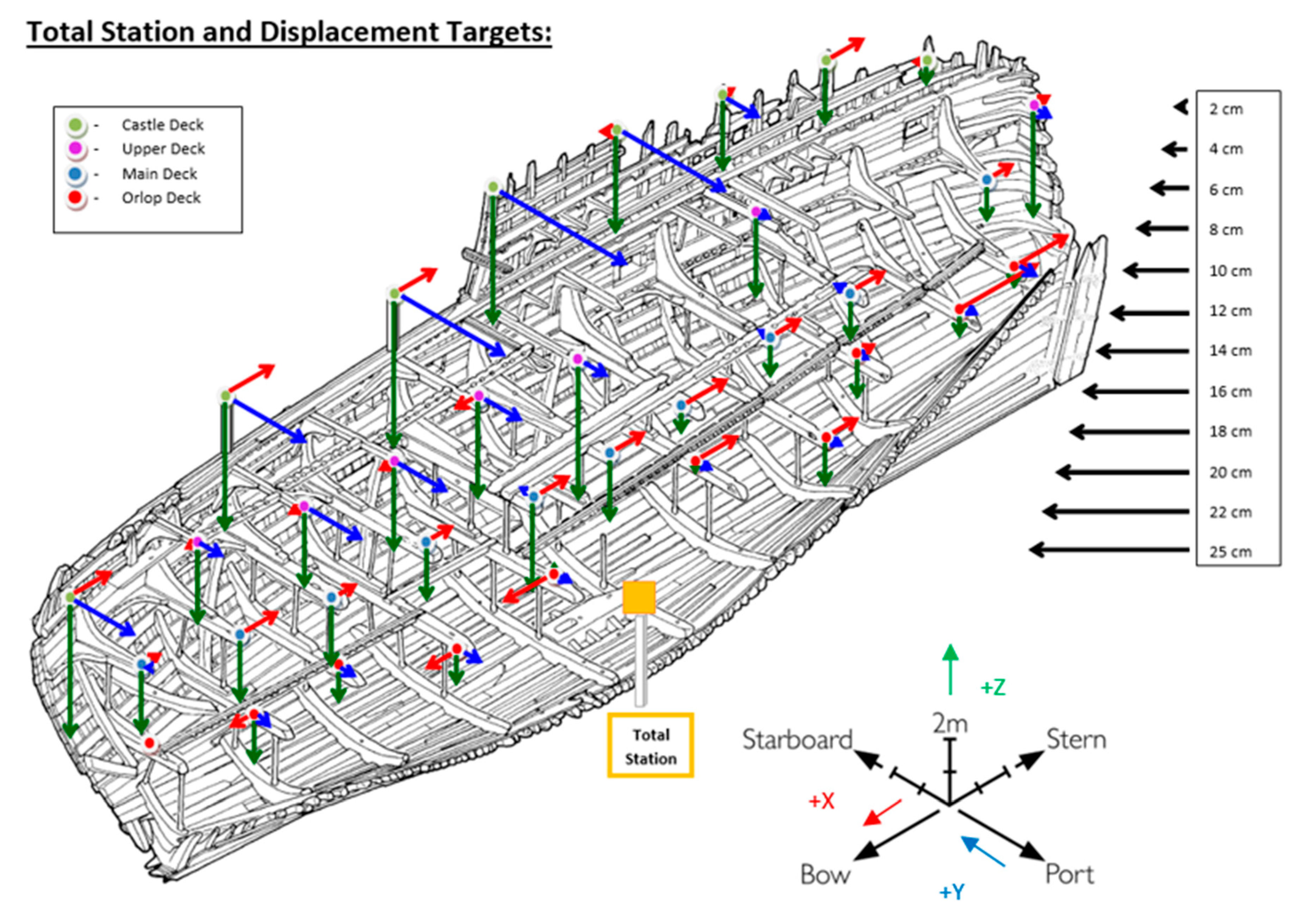

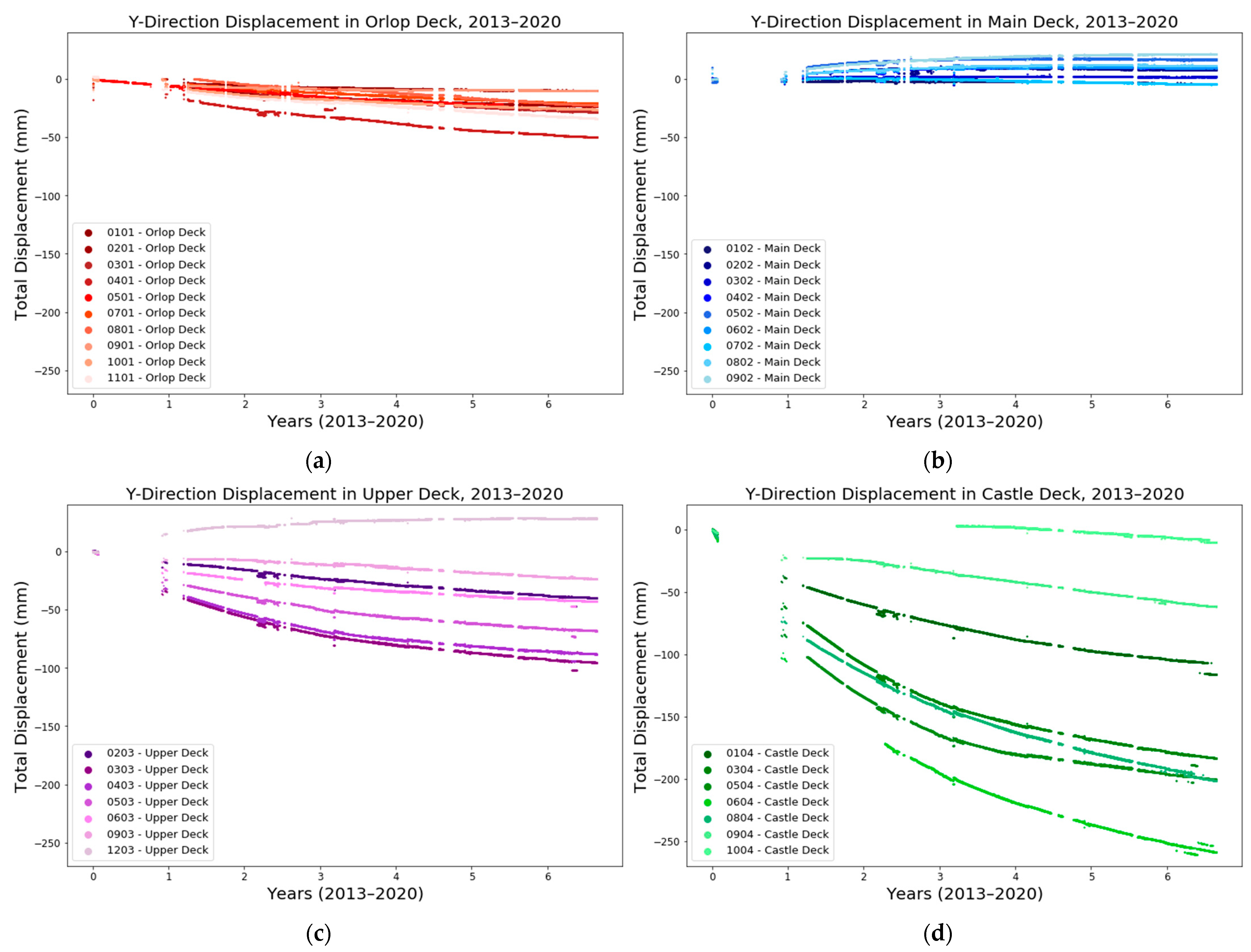
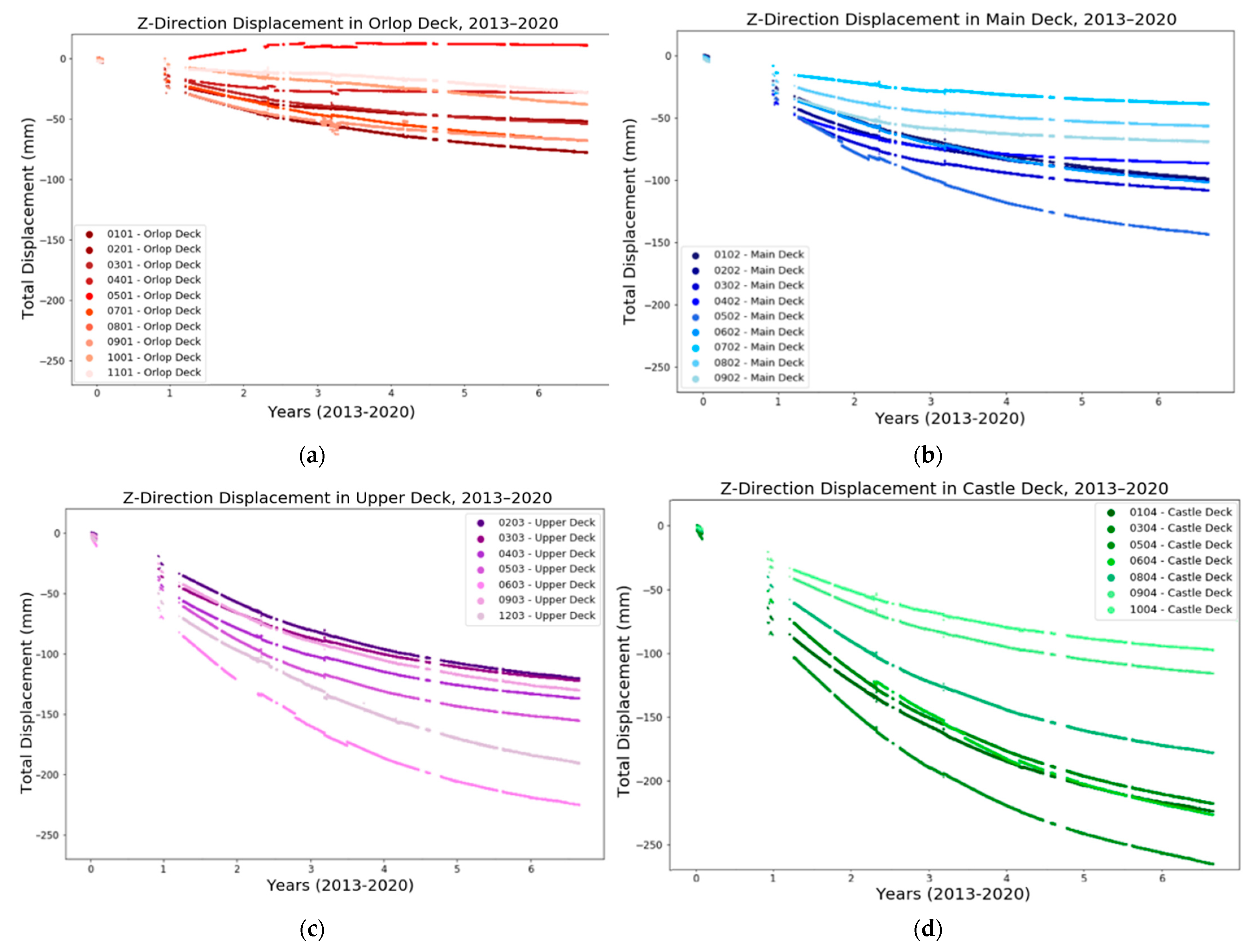
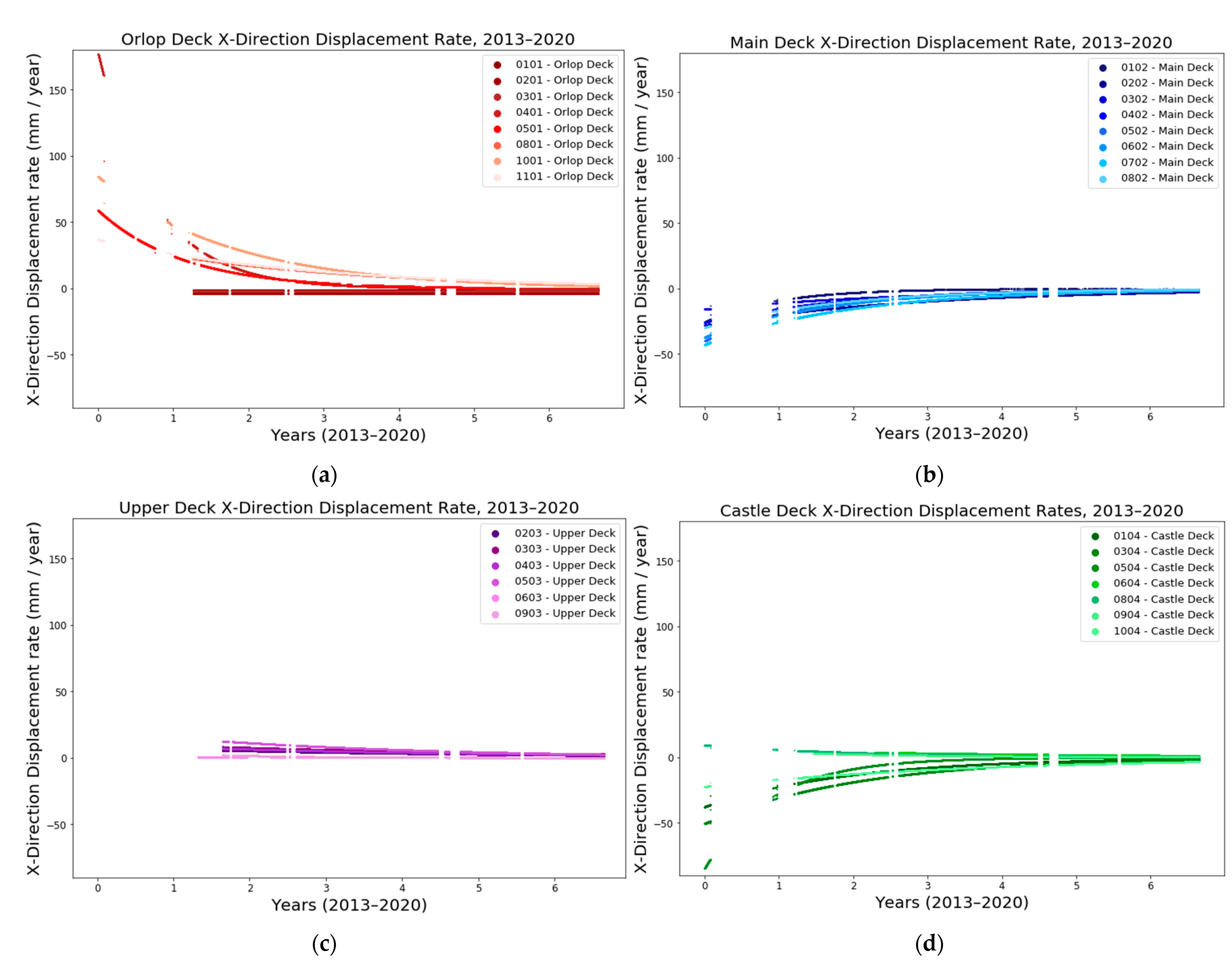


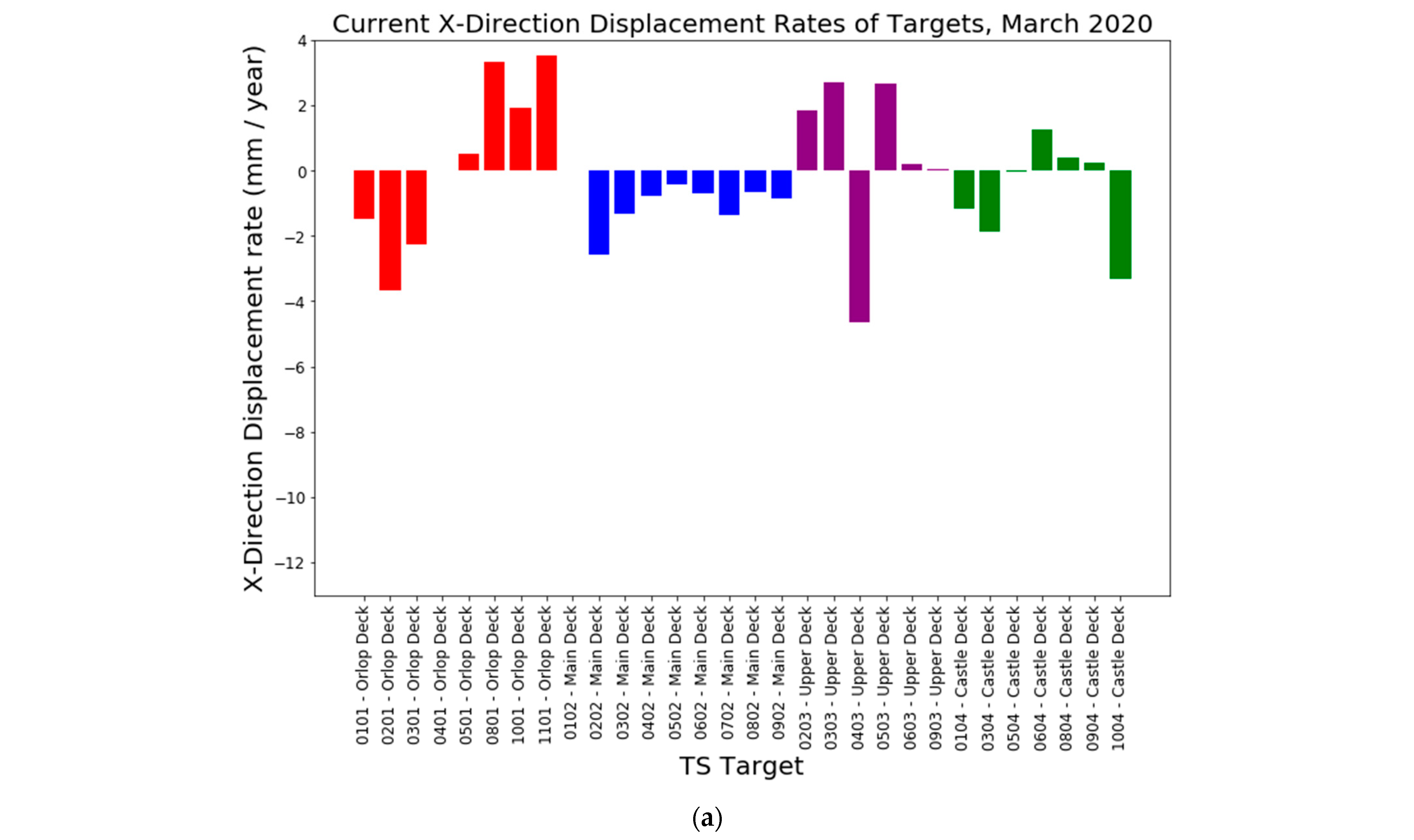
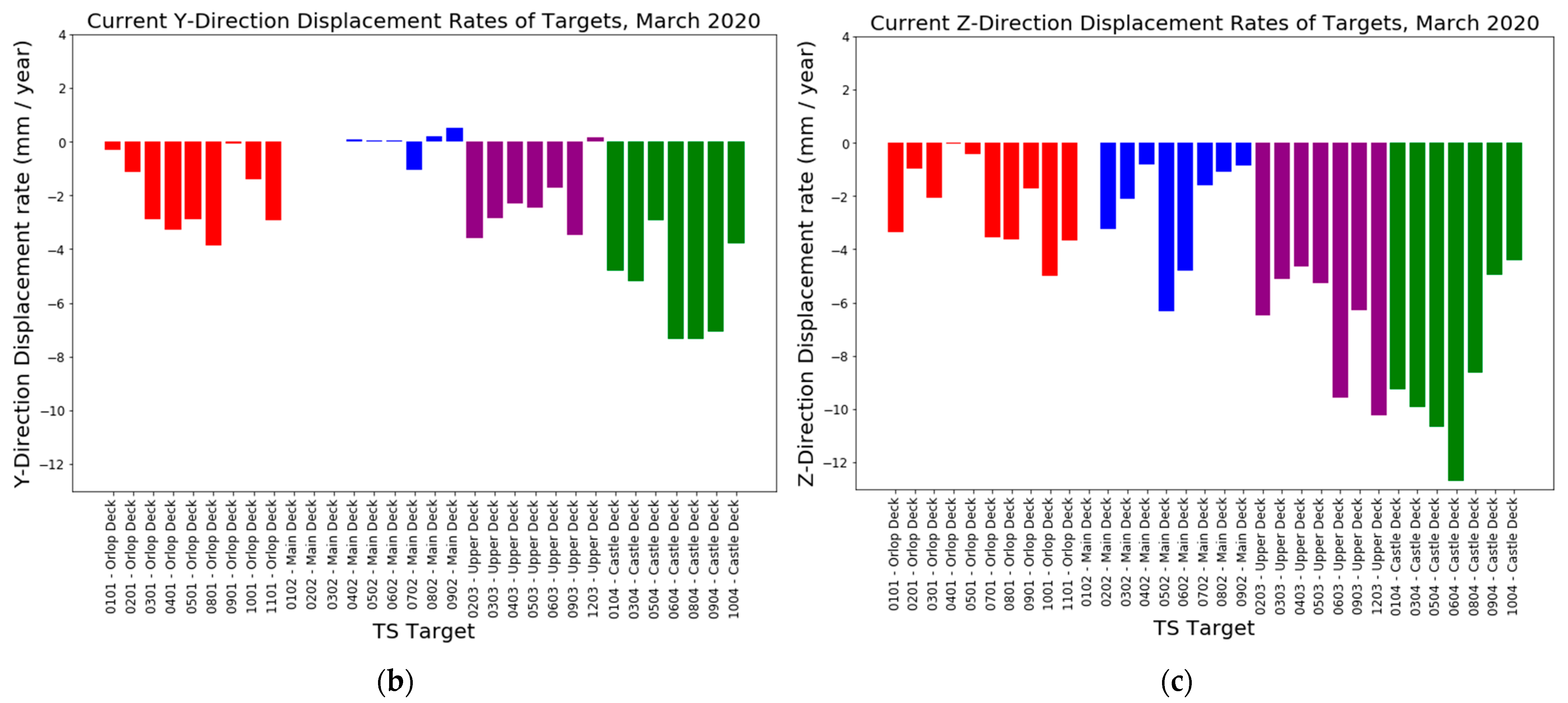
Publisher’s Note: MDPI stays neutral with regard to jurisdictional claims in published maps and institutional affiliations. |
© 2021 by the authors. Licensee MDPI, Basel, Switzerland. This article is an open access article distributed under the terms and conditions of the Creative Commons Attribution (CC BY) license (https://creativecommons.org/licenses/by/4.0/).
Share and Cite
Collett, H.; Bouville, F.; Giuliani, F.; Schofield, E. Structural Monitoring of a Large Archaeological Wooden Structure in Real Time, Post PEG Treatment. Forests 2021, 12, 1788. https://doi.org/10.3390/f12121788
Collett H, Bouville F, Giuliani F, Schofield E. Structural Monitoring of a Large Archaeological Wooden Structure in Real Time, Post PEG Treatment. Forests. 2021; 12(12):1788. https://doi.org/10.3390/f12121788
Chicago/Turabian StyleCollett, Hugh, Florian Bouville, Finn Giuliani, and Eleanor Schofield. 2021. "Structural Monitoring of a Large Archaeological Wooden Structure in Real Time, Post PEG Treatment" Forests 12, no. 12: 1788. https://doi.org/10.3390/f12121788
APA StyleCollett, H., Bouville, F., Giuliani, F., & Schofield, E. (2021). Structural Monitoring of a Large Archaeological Wooden Structure in Real Time, Post PEG Treatment. Forests, 12(12), 1788. https://doi.org/10.3390/f12121788





